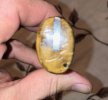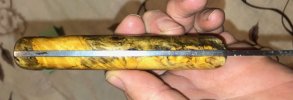Sulaco
Gold Member
- Joined
- Nov 15, 2003
- Messages
- 2,421
I bought some blades to handle and finished up my first one today. I used some scales I have had forever, I think they came with some old kit I bought years ago. Some kind of died plywood.
I used cutler's rivets and epoxied the scales to the tang. I rought shaped them with hand tools and a cheap HF belt sander. I did the best I could having never done this before.
Next time I plan to just use brass or steel rod for pins and my other scales are all non-stabilized wood.
I have a couple of questions. Is acetone the best thing to prep things before glue up?
Can I use pin material that is smaller in diameter than the holes in the tang? I wasn't sure how drilling out the scales (I have a drill press) would work. I guess if I secure the tang to the scale when I drill it won't matter?
I am using DevCon 30min epoxy. Is that the best thing or is there something else? It seems to have worked really well from what I can tell. No gaps or issues after removing clamps.
What is the secret to keeping epoxy off of the blade? I wiped it up but it still got on the blade up near the ricasso and its really hard to clean off.
I have several more scales type kits to do and hope to keep improving my technique before I invest in a real belt sander, heat treat oven (want to work towards stock removal), etc. I also have a couple of rat/hidden tangs I plan to work on soon so any tips there are appreciated as well.

I used cutler's rivets and epoxied the scales to the tang. I rought shaped them with hand tools and a cheap HF belt sander. I did the best I could having never done this before.
Next time I plan to just use brass or steel rod for pins and my other scales are all non-stabilized wood.
I have a couple of questions. Is acetone the best thing to prep things before glue up?
Can I use pin material that is smaller in diameter than the holes in the tang? I wasn't sure how drilling out the scales (I have a drill press) would work. I guess if I secure the tang to the scale when I drill it won't matter?
I am using DevCon 30min epoxy. Is that the best thing or is there something else? It seems to have worked really well from what I can tell. No gaps or issues after removing clamps.
What is the secret to keeping epoxy off of the blade? I wiped it up but it still got on the blade up near the ricasso and its really hard to clean off.
I have several more scales type kits to do and hope to keep improving my technique before I invest in a real belt sander, heat treat oven (want to work towards stock removal), etc. I also have a couple of rat/hidden tangs I plan to work on soon so any tips there are appreciated as well.





